Antibacterial Properties of Non-Modified Wool, Determined and Discussed in Relation to ISO 20645:2004 Standard
Abstract
1. Introduction
2. Results and Discussion
2.1. Agar Diffusion Test
2.2. Comparison to Literature Data
2.3. Viable Cell Count
2.4. X-ray Microtomography
3. Materials and Methods
3.1. Bacterial Strains
3.2. Textile Materials
3.3. Antibacterial Testing
3.4. Determining the Number of Bacteria Attached to Textile Samples
3.5. X-ray Microtomography
3.6. Statistical Analysis
4. Conclusions
Author Contributions
Funding
Institutional Review Board Statement
Informed Consent Statement
Data Availability Statement
Conflicts of Interest
Sample Availability
References
- Caven, B.; Redl, B.; Bechtold, T. An investigation into the possible antibacterial properties of wool fibers. Text. Res. J. 2019, 89, 510–516. [Google Scholar] [CrossRef]
- Holcombe, B. Wool performance apparel for sport. In Advances in Wool Technology; Johnson, N.A.G., Russell, I.M., Eds.; Woodhead Publishing Limited: Cambridge, UK, 2009; pp. 265–283. [Google Scholar]
- Johnson, N.A.G.; Wood, E.J.; Ingham, P.E.; McNeil, S.J.; McFarlane, I.D. Wool as a Technical Fibre. J. Text. Inst. 2003, 94, 26–41. [Google Scholar] [CrossRef]
- Yu, D.; Tian, W.; Sun, B.; Li, Y.; Wang, W.; Tian, W. Preparation of silver-plated wool fabric with antibacterial and anti-mould properties. Mater. Lett. 2015, 151, 1–4. [Google Scholar] [CrossRef]
- Dickerson, M.B.; Sierra, A.A.; Bedford, N.M.; Lyon, W.J.; Gruner, W.E.; Mirau, P.A.; Naik, R.R. Keratin-based antimicrobial textiles, films, and nanofibers. J. Mater. Chem. B 2013, 1, 5505–5514. [Google Scholar] [CrossRef] [PubMed]
- Peran, J.; Ercegovic Razic, S.; Sutlovic, A.; Ivankovic, T.; Glogar, M.I. Oxygen plasma pretreatment improves dyeing and antimicrobial properties of wool fabric dyed with natural extract from pomegranate peel. Color. Technol. 2020, 136, 177–187. [Google Scholar] [CrossRef]
- McNeil, S. The Removal of Indoor Air Comtaminants by Wool Textiles; Technical Bulletin; AgResearch: Christchurch, New Zealand, 2015. [Google Scholar] [CrossRef]
- Yilmaz, E.; Celik, P.; Korlu, A.; Yapar, S. Determination of the odour adsorption behaviour of wool. Text. Leather Rev. 2020, 3, 30–39. [Google Scholar] [CrossRef][Green Version]
- Causer, S.M.; McMillan, R.C.; Bryson, W.G. The role of wool carpets and furnishings in reducing indoor air pollution. In Proceedings of the 9th International Wool Textile Research Conference, Biella, Italy, 28 June–5 July 1995; pp. 155–161. [Google Scholar]
- Pinho, E.; Magalhães, L.; Henriques, M.; Oliveira, R. Antimicrobial activity assessment of textiles: Standard methods comparison. Ann. Microbiol. 2011, 61, 493–498. [Google Scholar] [CrossRef]
- Benesovsky, P. Determination of antibacterial activity of textiles—Methods, results and their interpretation. In Proceedings of the ICAMS 2010—3rd International Conference on Advanced Materials and Systems, Bucharest, Romania, 16–18 September 2010. [Google Scholar]
- AATCC 147:2004; Antimicrobial Activity Assessment of Textile Materials: Parallel Streak Method. American Association of Textile Chemists and Colorists: Research Triangle Park, NC, USA, 2004.
- Liu, X.; Lin, T.; Peng, B.; Wang, X. Antibacterial activity of capsaicin-coated wool fabric. Text. Res. J. 2012, 82, 584–590. [Google Scholar] [CrossRef]
- Gomes, A.P.; Mano, J.F.; Queiroz, J.A.; Gouveia, I.C. Layer-by-layer deposition of antimicrobial polymers on cellulosic fibers: A new strategy to develop bioactive textiles. Polym. Adv. Technol. 2013, 24, 1005–1010. [Google Scholar] [CrossRef]
- Liu, H.; Lee, Y.Y.; Norsten, T.B.; Chong, K. In situ formation of anti-bacterial silver nanoparticles on cotton textiles. J. Ind. Text. 2014, 44, 198–210. [Google Scholar] [CrossRef]
- Li, Z.; Tang, H.; Yuan, W.; Song, W.; Niu, Y.; Yan, L.; Yu, M.; Dai, M.; Feng, S.; Wang, M.; et al. Ag nanoparticle–ZnO nanowire hybrid nanostructures as enhanced and robust antimicrobial textiles via a green chemical approach. Nanotechnology 2014, 25, 145702. [Google Scholar] [CrossRef] [PubMed]
- Haase, H.; Jordan, L.; Keitel, L.; Keil, C.; Mahltig, B. Comparison of methods for determining the effectiveness of antibacterial functionalized textiles. PLoS ONE 2017, 12, e0188304. [Google Scholar] [CrossRef] [PubMed]
- Pollini, M.; Paladini, F.; Licciulli, A.; Maffezzoli, A.; Nicolais, L.; Sannino, A. Silver-coated wool yarns with durable antibacterial properties. J. Appl. Polym. Sci. 2012, 125, 2239–2244. [Google Scholar] [CrossRef]
- Abdel-Fattah, S.H.; El-Khatib, E.M. Wool fabrics with antibacterial properties. RJTA 2012, 16, 42–48. [Google Scholar] [CrossRef]
- Moellebjerg, A.; Meyer, R. The bacterial lifecycle in cotton and polyester textiles. In Proceedings of the Biofilms 9 Conference, Karlsruhe, Germany, 29 September–1 October 2020. [Google Scholar] [CrossRef]
- Sanders, D.; Grunden, A.; Dunn, R.R. A review of clothing microbiology: The history of clothing and the role of microbes in textiles. Biol. Lett. 2021, 17, 20200700. [Google Scholar] [CrossRef] [PubMed]
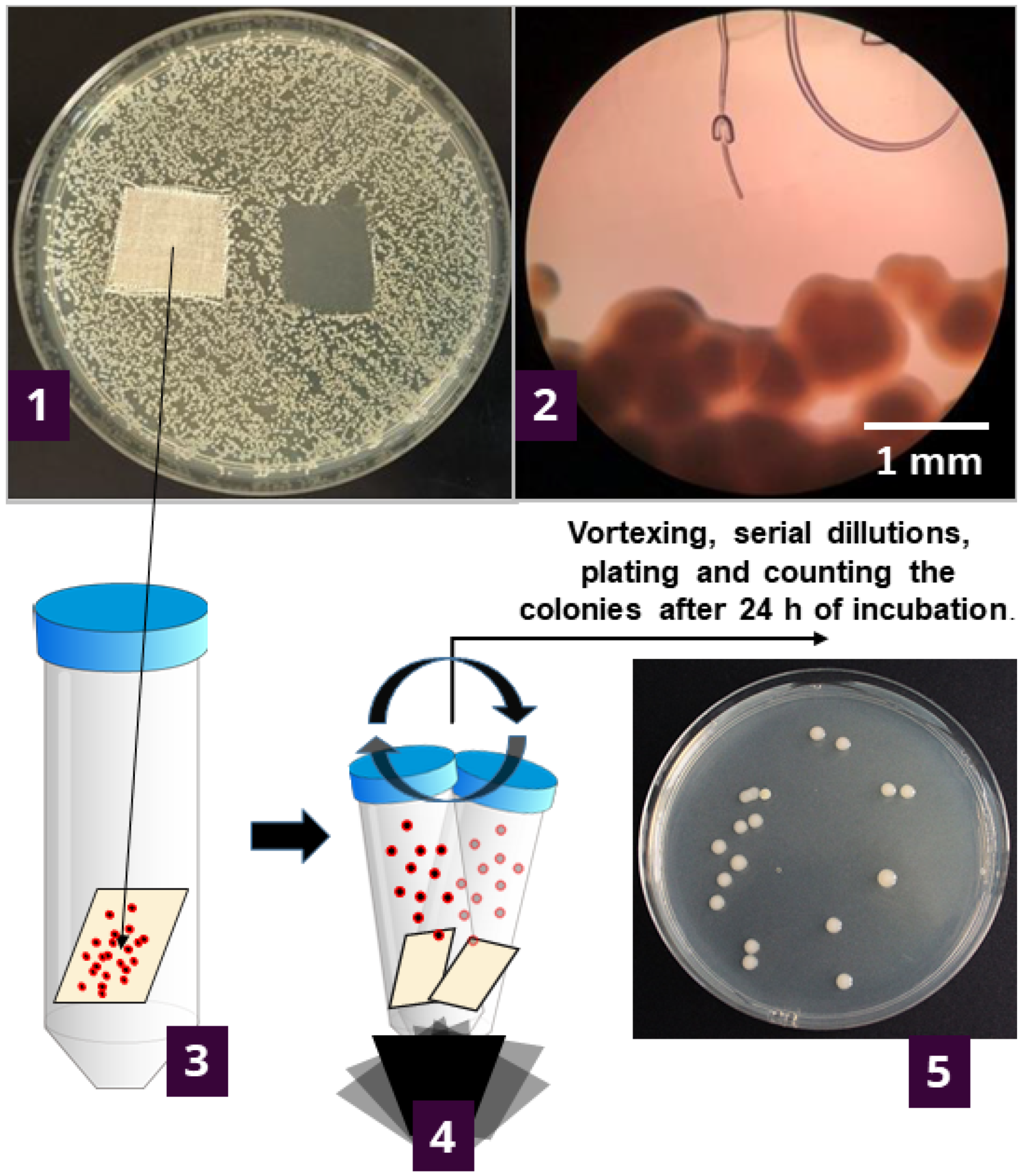

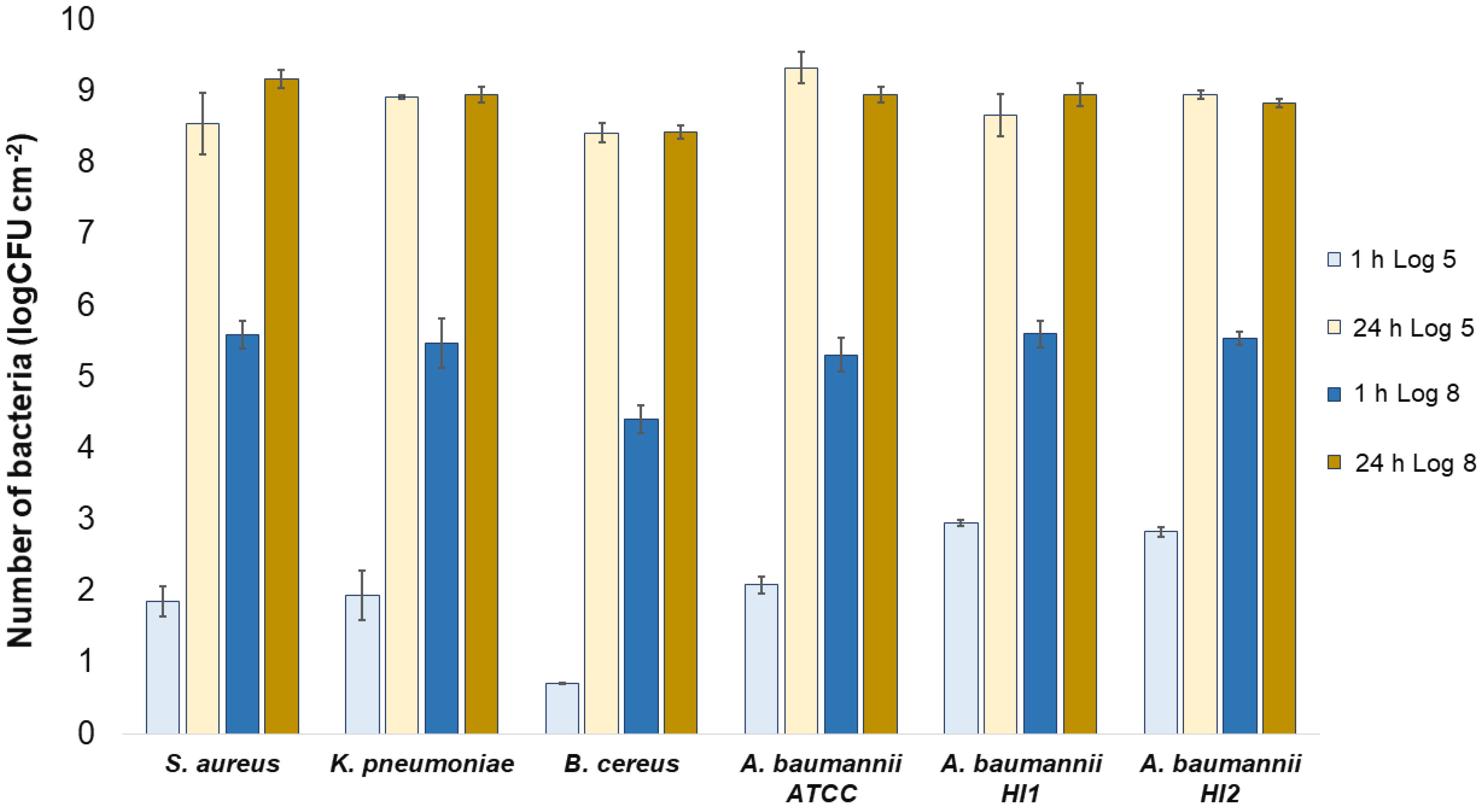
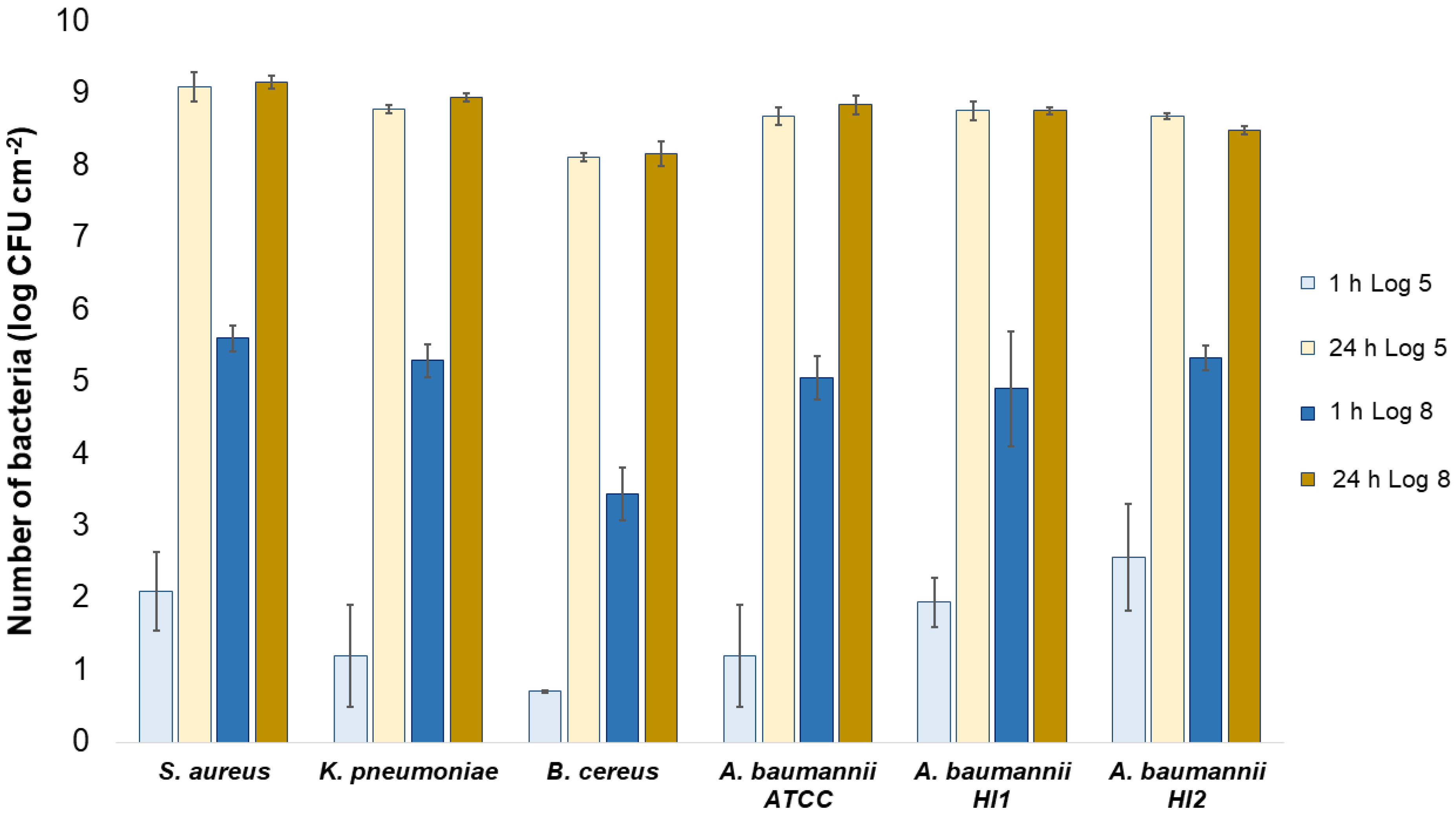
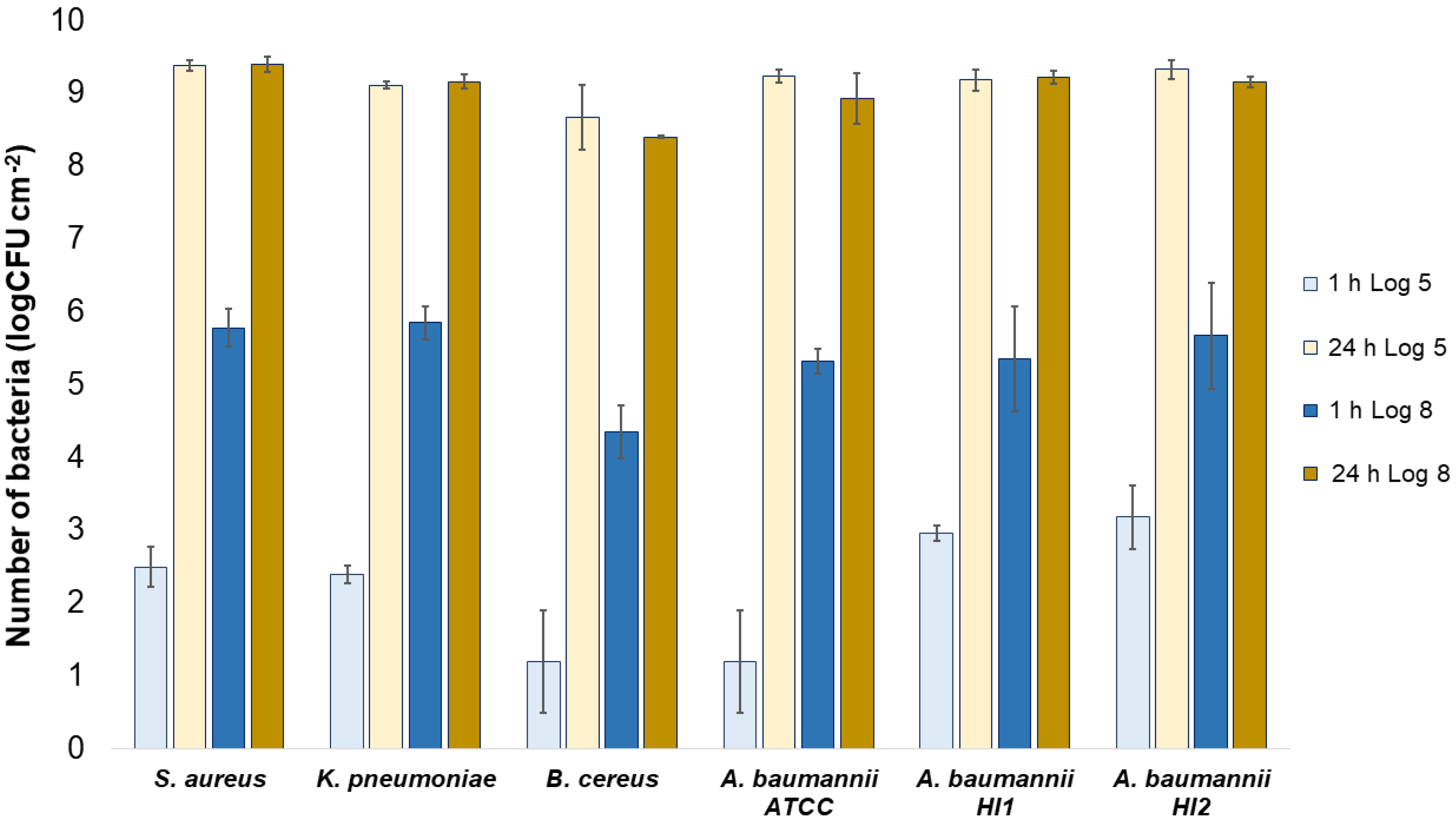

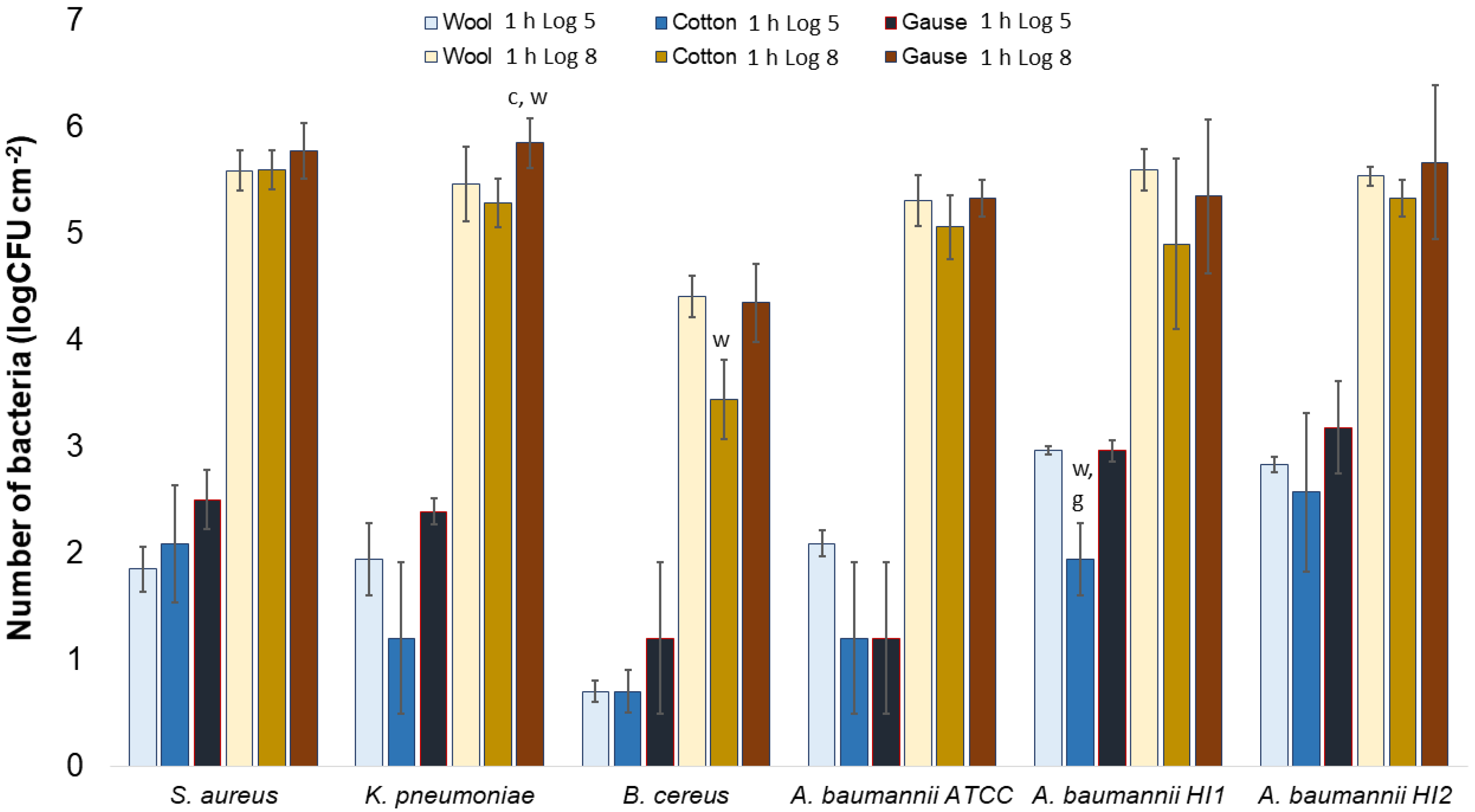
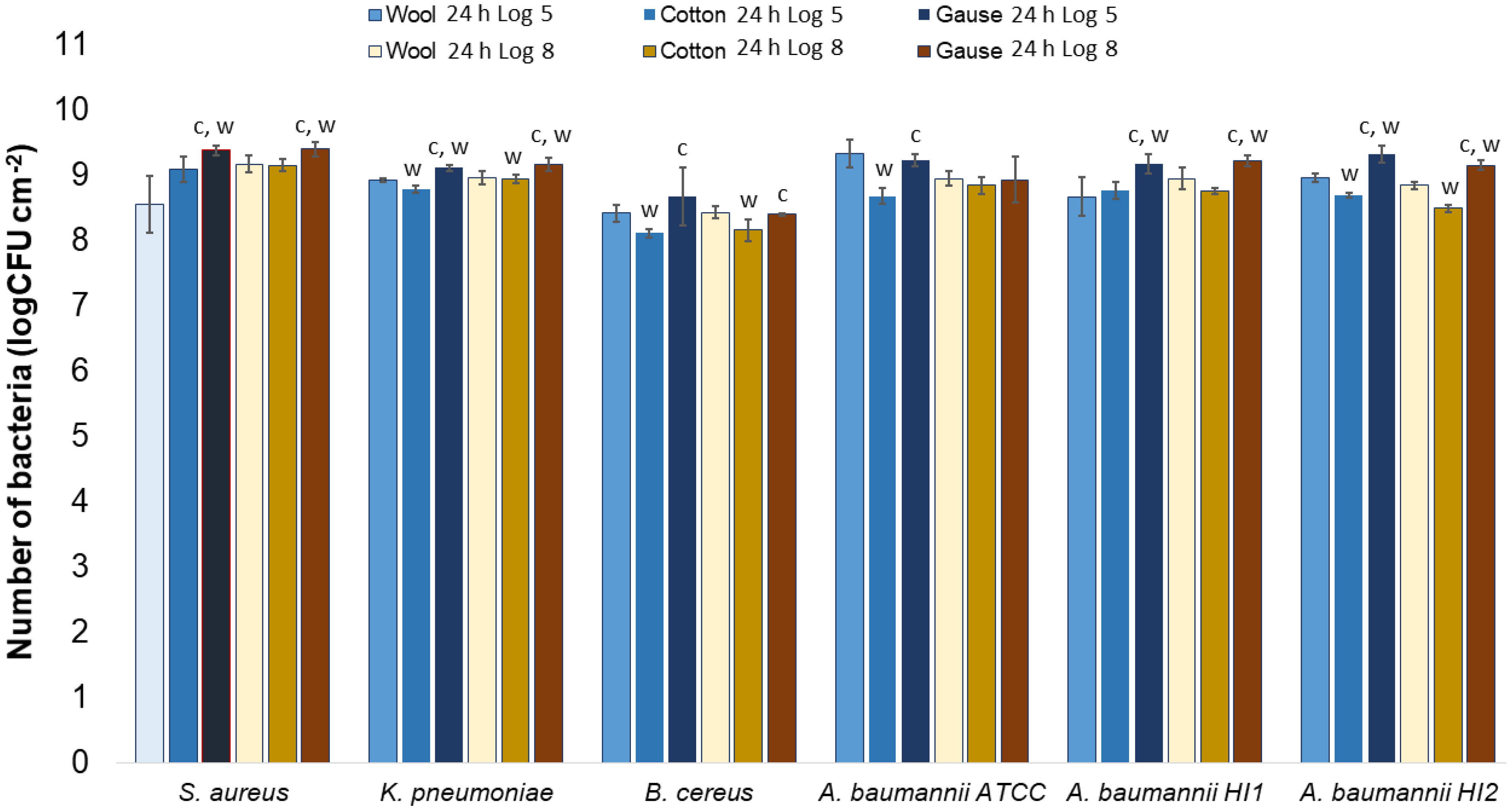
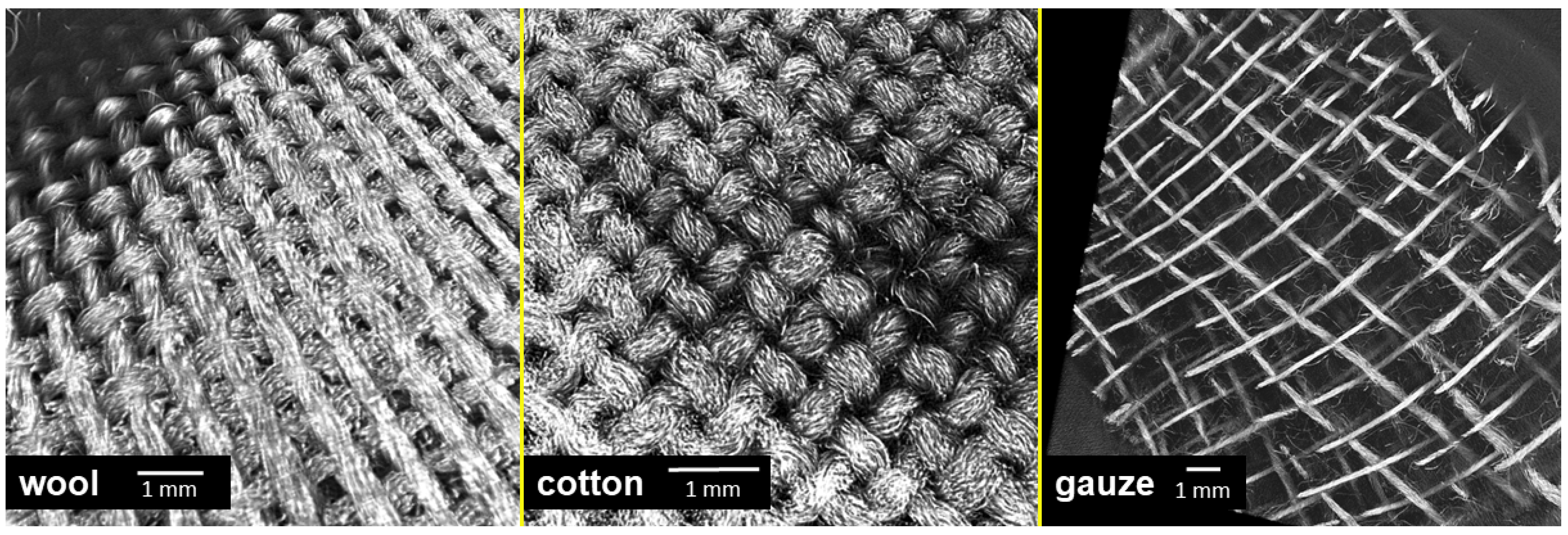
| Bacteria | Sample | Growth Under the Specimen | Assessment of Antibacterial Efficacy Adopted from ISO 20645:2004 |
|---|---|---|---|
| S. aureus ATCC 25923 | Wool | none/slight | good effect/limit of efficacy |
| Cotton | heavy | insufficient effect | |
| Gauze | slight/moderate | limit of efficacy/insufficient effect | |
| K. pneumoniae ATCC 11296 | Wool | none | good effect |
| Cotton | none/slight | good effect/limit of efficacy | |
| Gauze | slight | limit of efficacy | |
| B. cereus LBK 4080 | Wool | none | good effect |
| Cotton | none/slight | good effect/limit of efficacy | |
| Gauze | slight/moderate | limit of efficacy/insufficient effect | |
| A. baumannii ATCC 11296 | Wool | none | good effect |
| Cotton | none | good effect | |
| Gauze | slight | limit of efficacy | |
| A. baumannii HI1 | Wool | none | good effect |
| Cotton | none/slight | good effect/limit of efficacy | |
| Gauze | slight | limit of efficacy | |
| A. baumannii HI2 | Wool | none | good effect |
| Cotton | none | good effect | |
| Gauze | slight | limit of efficacy |
Publisher’s Note: MDPI stays neutral with regard to jurisdictional claims in published maps and institutional affiliations. |
© 2022 by the authors. Licensee MDPI, Basel, Switzerland. This article is an open access article distributed under the terms and conditions of the Creative Commons Attribution (CC BY) license (https://creativecommons.org/licenses/by/4.0/).
Share and Cite
Ivankovic, T.; Rajic, A.; Ercegovic Razic, S.; Rolland du Roscoat, S.; Skenderi, Z. Antibacterial Properties of Non-Modified Wool, Determined and Discussed in Relation to ISO 20645:2004 Standard. Molecules 2022, 27, 1876. https://doi.org/10.3390/molecules27061876
Ivankovic T, Rajic A, Ercegovic Razic S, Rolland du Roscoat S, Skenderi Z. Antibacterial Properties of Non-Modified Wool, Determined and Discussed in Relation to ISO 20645:2004 Standard. Molecules. 2022; 27(6):1876. https://doi.org/10.3390/molecules27061876
Chicago/Turabian StyleIvankovic, Tomislav, Antonija Rajic, Sanja Ercegovic Razic, Sabine Rolland du Roscoat, and Zenun Skenderi. 2022. "Antibacterial Properties of Non-Modified Wool, Determined and Discussed in Relation to ISO 20645:2004 Standard" Molecules 27, no. 6: 1876. https://doi.org/10.3390/molecules27061876
APA StyleIvankovic, T., Rajic, A., Ercegovic Razic, S., Rolland du Roscoat, S., & Skenderi, Z. (2022). Antibacterial Properties of Non-Modified Wool, Determined and Discussed in Relation to ISO 20645:2004 Standard. Molecules, 27(6), 1876. https://doi.org/10.3390/molecules27061876







